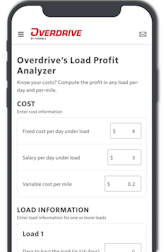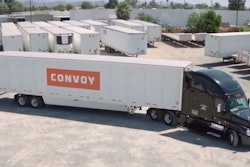President Donald Trump on Saturday, February 1, officially announced tariffs on imports coming into the country from Canada and Mexico, two of the United States' largest global import and export partners, making good on his campaign promise to tack a 25% duty on goods imported from those countries. Reports Sunday suggested the tariffs will take effect Tuesday, February 4, along with a 10% duty on imports from China and, according to Canadian Prime Minister Justin Trudea, retaliatory 25% tariffs on U.S. goods imported to Canada.
Mexican President Claudia Sheinbaum has vowed similar retaliatory duties in what amounts to an intensifying battle in what could become a trade war.
Tariffs, while not an uncommon economic tool, might typically be used to rebalance an off-kilter playing field when imported goods have an unfair advantage over similar goods produced in the U.S., noted e2open Group Vice President of Product Strategy John Lash, in conversation with Overdrive sister fleet publication CCJ. Lash offered the example of a foreign government that subsidized the cost of production of goods that are also produced domestically, making those imported products far less expensive.
The Biden administration rolled out a 100% tariff on electric vehicles manufactured in China, for instance, a 25% tariff on lithium-ion EV batteries and a 50% tariff on photovoltaic solar cells, following Trump tariffs on steel and aluminum during his first term, among others, aimed in part at Chinese products. A 50% tariff on semiconductors made in China goes into effect this year, also.

Trump on Saturday added a broad 10% tariff on Chinese goods imported into the U.S.
Trump's new tariffs, however, are more expressly punitive in intention than fair competition-boosting -- they're aimed at pressuring Canada and Mexico to act on illicit drugs and illegal immigrants crossing the north and south U.S. borders, with similar reasons noted about intensification of tariffs on Chinese imports.
"This is the parents saying 'I'm going to turn off the WiFi if you don't clean your room,'" said Tom Perrone, senior vice president of global professional services at Project44. "[Trump] wants fentanyl and illegal immigration stopped and they're using tariffs to do that."
Yet in comments from his confimation hearings in January, recently confirmed U.S. Treasury Secretary Scott Bessent talked about enforcing Trump's threatened tariffs in terms related expressly to fair competition and increasing domestic industrial output.
"The goal of tariffs is to increase U.S. industrial capacity, create and protect U.S. jobs, and to protect our national security by ensuring our supply chains, particularly for our military, are not reliant on our adversaries," he testified before the Senate Committee on Finance. "I believe that tariffs can be an important source of government revenue and can help fund investments that benefit American families, workers and companies."
He went on to say that tariffs would be implemented along with other economic policies, including regulatory relief and income tax adjustments, and that tariffs would be designed to target "the appropriate range of jurisdictions and products, with rates calibrated to advance American interests."
When pressed by the committee on exemptions, Bessent said he looked forward to working with the Office of the United States Trade Representative and the Department of Commerce to ensure tariffs are implemented fairly for Americans. He did not list any specific exemptions he might seek. (Notably, the announced tariffs on Canadian imports contain a smaller levy placed on oil and some other energy imports.)
[Related: Fuel prices surging to begin 2025]
Imported products the tariffs cover are likely to increase in price. Mexican imports, in particular, are wide-ranging and encompass everything from trucks to avocados. According to the Office of the United States Trade Representative, trade with Mexico totaled $855.1 billion in 2022 with $493.1 billion in imports.
Chief exports from Mexico to the U.S. included computers, cars and motor vehicle parts and accessories. A significant number of those parts and accessories are earmarked for heavy-duty trucks and trailers. Daimler, International and Paccar all have manufacturing facilities in Mexico, and Volvo is building a new plant in Monterrey. With OEM plants come scores of suppliers, such as Bendix, Phillips Industries, Grote, BorgWarner and others, who have manufacturing plants in Mexico.
[Related: Truckers' top 5 priorities for incoming Trump administration]
Could tariffs 'wreck' a recovery in freight markets?
Trucking industry groups and watchers began reacting to the tariffs Friday. Most comments came in opposition.
MEMA -- the Vehicle Suppliers Association, representing OE manufacturers and aftermarket suppliers, told Overdrive sister supplier-focused publication TPS that it "echoes the profound concerns expressed by sectors across the U.S. economy and reinforces our opposition to a 25% tariff on goods from Mexico and Canada, which will place additional pressure on the supplier industry and impede the ability of supplier companies to grow, invest, and operate their businesses,” the organization stated. “Such tariffs would have severe consequences for the U.S. vehicle supplier industry, jeopardizing American jobs, increasing costs for consumers, and undermining the highly integrated North American supply chain that is critical to U.S. competitiveness.”
American Trucking Associations President and CEO Chris Spear noted his concern that tariffs of these levels could stifle a trucking recovery that is still in its infancy stage by decreasing freight volumes and increasing costs for truckers and trucking companies.
"A 25% tariff levied on Mexico could see the price of a new tractor increase by as much as $35,000," he contended. "That is cost-prohibitive for many small carriers, and for larger fleets, it would add tens of millions of dollars in annual operating costs."
[Related: Readers mixed on potential domestic freight impacts of 2018 tariffs]
Spear added that efforts to fight drug and human trafficking have long been priorities of the trucking industry, and the industry supports policies "that will secure our borders and protect legitimate trade," he said, "but we also recognize the unintended consequences that substantial tariffs could have over the long-term, including higher consumer costs on the wide range of goods that cross our borders by truck, including food, automobiles, televisions, computers, furniture, and other key manufacturing inputs."
Calling the administration's tariff moves tantamount to an actual "all-out tariff war," Jason Miller, associate professor of supply chain management at Michigan State University, felt these moved could "wreck the potential for a significant recovery in the trucking sector in 2025, both in terms of freight volumes and prices."
[Related: Trump II and the outlook for speed limiters, broker transparency, parking push and more]
Analyst Chris Brady of Commercial Motor Vehicle Consulting, commenting earlier in the week, prior to this weekend's tariff announcements, was more circumspect about positive or negative outcomes of tariff policy. Like other analysts, though, Brady's forecast for 2025 was for a reduction in spare capacity at fleets large and small, with gradually growing freight volumes to slowly swing the pricing pendulum toward for-hire carriers, resulting in moderate increases in freight rates to cover higher operating costs and improve operating margins. "Gradual improvements in profitability in the for-hire trucking industry during 2025," he wrote, "will support higher investment spending on trucks to expand capacity to meet growing freight volumes."
Yet tariffs hung in Brady's forecast as a potential risk factor, depending on just how it all plays out. "A broad increase in tariffs across countries," Brady wrote, "may weigh on U.S. exports as other countries enact retaliatory tariffs in response to higher U.S. tariffs. No leader wants to be seen as weak, so other countries are likely to enact retaliatory tariffs," as now seems to be in offing.
"The U.S.’s most competitive industries are global," Brady added, "and approximately 25% of industrial production is directly or indirectly related to exports, so a tariff war has the potential to weigh on U.S. industrial production, and as a result, the freight environment as well." --Jason Cannon, Lucas Deal, Pamella De Leon, and Todd Dills contributed reporting.
[Related: Will Trump tariff policies send freight rates skyrocketing?]








